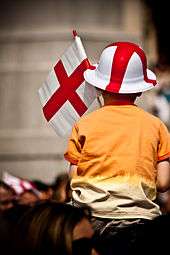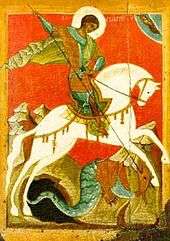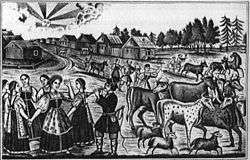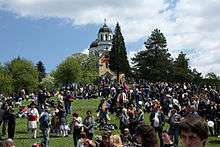Saint George's Day
| Saint George's Day | |
|---|---|
 | |
| Observed by |
Roman Catholic Church (see calendar) Anglican Communion (see calendars) Eastern Orthodox Church (see calendar) Oriental Orthodox Church (see calendar) Nations of which Saint George is the patron saint |
| Type | Feast day; national day of England. |
| Observances | Church services, flying of the St George's Cross |
| Date | 23 April, 24 April, 6 May, 23 November |
| Frequency | Annual |
| Related to |
|
Saint George's Day, also known as the Feast of Saint George, is the feast day of Saint George as celebrated by various Christian Churches and by the several nations, kingdoms, countries, and cities of which Saint George is the patron saint.
Saint George's Day is celebrated on 23 April, the traditionally accepted date of the saint's death in Diocletianic Persecution of AD 303. For those Eastern Orthodox Churches which use the Julian calendar, this date currently falls on the day of 6 May of the Gregorian calendar.
Date
In the General Calendar of the Roman Rite, the feast of Saint George is on 23 April. In the Tridentine Calendar it was given the rank of "Semidouble". In Pope Pius XII's 1955 calendar this rank is reduced to "Simple". In Pope John XXIII's 1960 calendar the celebration is just a "Commemoration". In Pope Paul VI's revision of the calendar that came into force in 1969, it was given the equivalent rank of a "Memorial", of optional use. In some countries, such as England, the rank is higher.
Since Easter often falls close to Saint George's Day, the church celebration of the feast may be moved from 23 April: For 2011 and 2014 the Anglican and Catholic calendars celebrated Saint George's Day on the first Monday after the Octave of Easter (see Easter Week) (2 May 2011 and 28 April 2014, respectively).[1][2][3] Similarly, the Eastern Orthodox celebration of the feast moves accordingly to the first Monday after Easter or, as it is sometimes called, to the Monday of Bright Week. The church celebration may also be moved if the 23rd April falls on a Sunday; in England and Wales the Catholic calendar celebrates Saint George on Monday 24 April 2017 (because Sunday is the celebration of Christ's Resurrection, which is far more important than any saint's commemoration).
Besides the 23 April feast, some Orthodox Churches have additional feasts dedicated to St George. The country of Georgia celebrates the feast of St. George on 23 April and, more prominently, 10 November (Julian calendar), which currently fall on 6 May and 23 November (Gregorian calendar), respectively.[4] The Russian Orthodox Church celebrates the dedication of the Church of St George in Kiev by Yaroslav the Wise in 1051 on 26 November (Julian calendar), which currently falls on 9 December on the Gregorian calendar.
Western tradition
England and Anglican tradition



The earliest documented mention of St. George in England comes from the venerable Bede (c. 673–735).[5] His feast day is also mentioned in the Durham Collectar, a ninth-century liturgical work.[6] The will of Alfred the Great is said to refer to the saint, in a reference to the church of Fordington, Dorset.[7] At Fordington a stone over the south door records the miraculous appearance of St. George to lead crusaders into battle.[5] Early (c. 10th century) dedications of churches to St. George are noted in England, for example at Fordingham, Dorset, at Thetford, Southwark and Doncaster.[7] In the past, historians mistakenly pointed to the Synod of Oxford in 1222 as elevating the feast to special prominence, but the earliest manuscripts of the synod’s declaration do not mention the feast of St George.[8] The declarations of the Province of Canterbury in 1415 and the Province of York in 1421 elevated the feast to a double major, and as a result, work was prohibited and church attendance was mandatory.[9] Edward III (1327–1377) put his Order of the Garter (founded c. 1348) under the banner of St. George.[5] This order is still the foremost order of knighthood in England and St George's Chapel at Windsor Castle was built by Edward IV and Henry VII in honour of the order.[5] The badge of the Order shows Saint George on horseback slaying the dragon.[5] Froissart observed the English invoking St. George as a battle cry on several occasions during the Hundred Years' War (1337–1453).[7] Certain English soldiers also displayed the pennon of St George.[10] In his play Henry V, William Shakespeare famously invokes the Saint at Harfleur prior to the battle of Agincourt (1415): "Follow your spirit, and upon this charge Cry 'God for Harry, England, and Saint George!'" At Agincourt many believed they saw him fighting on the English side.[5]
St George's Day was a major feast and national holiday in England on a par with Christmas from the early 15th century.[11] The Cross of St. George was flown in 1497 by John Cabot on his voyage to discover Newfoundland and later by Sir Francis Drake and Sir Walter Raleigh. In 1620 it was the flag that was flown on the foremast of the Mayflower (with the early Union Flag combining St. George's Cross of England with St. Andrew's Saltire of Scotland on the mainmast) when the Pilgrim Fathers arrived in Plymouth, Massachusetts.
The tradition of celebration St George's day had waned by the end of the 18th century after the union of England and Scotland.[12] Nevertheless, the link with St. George continues today, for example Salisbury holds an annual St. George's Day pageant, the origins of which are believed to go back to the 13th century.[7] In recent years the popularity of St. George's Day appears to be increasing gradually. BBC Radio 3 had a full programme of St. George's Day events in 2006, and Andrew Rosindell, Conservative MP for Romford, has been putting the argument forward in the House of Commons to make St. George's Day a public holiday. In early 2009, Mayor of London Boris Johnson spearheaded a campaign to encourage the celebration of St. George's Day. Today, St. George's day may be celebrated with anything English including morris dancing and Punch and Judy shows.[13] Additional celebrations may involve the commemoration of 23 April as Shakespeare's birthday/death.
A traditional custom on St George's day is to wear a red rose in one's lapel, though this is no longer widely practised. Another custom is to fly or adorn the St George's Cross flag in some way: pubs in particular can be seen on 23 April festooned with garlands of St George's crosses. It is customary for the hymn "Jerusalem" to be sung in cathedrals, churches and chapels on St George's Day, or on the Sunday closest to it. Traditional English food and drink may be consumed.
There is a growing reaction to the recent indifference to St George's Day. Organisations such as English Heritage and the Royal Society of St George have been encouraging celebrations. There have also been calls to replace St. George as patron saint of England on the grounds that he was an obscure figure who had no direct connection with the country.[14] However, there is no obvious consensus as to whom to replace him with, though names suggested include Edmund the Martyr,[15] Cuthbert of Lindisfarne, or Saint Alban, with the last having topped a BBC Radio 4 poll on the subject.[16] Recently there have been calls to reinstate St Edmund as the patron Saint of England as he was displaced by George some 400 years ago.[17]
Religious observance of St George's day changes when it is too close to Easter. According to the Church of England's calendar, when St. George's Day falls between Palm Sunday and the Second Sunday of Easter inclusive, it is moved to the Monday after the Second Sunday of Easter.[1][2] In 2011, for example, 23 April was Holy Saturday, so St George's Day was moved to Monday 2 May. The Catholic Church in England and Wales has a similar practice.[3]

The Scout movement has been celebrating St George's Day on 23 April since its first years, and St George is the patron saint of many other organisations.[18]
St. George's Day is celebrated on 23 April. St. George's Day is not an official national holiday in Canada. It is, however, a provincial holiday in Newfoundland and Labrador, where it is usually observed on the Monday nearest 23 April.
In sport, April 23 is also the anniversary of the St George Dragons Rugby League Football Club. The St George club coincidentally played their inaugural New South Wales Rugby League first grade match on St George's Day, 23 April 1921 at the Sydney Sports Ground in Australia.[19]
Roman Catholic traditions
Central Europe
In the Czech Republic, Saint George's Day (svátek sv. Jiří) comes on 24 April. The reason why it was moved from 23 April is, that there is a day of St. Adalbert of Prague (in Czech Svatý Vojtěch), Czech national patron saint, who was martyred on 23 April 997.[20] It is celebrated in a special way.
In Hungary, 24 April is the day of Saint George the Dragonkiller, thus it is the name day of men named György. It is also the Day of the Police, who honour him as a patron saint.
Iberian peninsula
Saint George is the patron saint of the former Crown of Aragon, since King Peter I of Aragon won the Battle of Alcoraz with his patronage. He is also patron of several cities. In most cases, the reason for those cities' relation with the Saint as their holy Patron is linked to historic events which happened during the "Reconquista."
As in the rest of the historical territory of the Crown of Aragon, the Feast of St George is celebrated enthusiastically in the Community of Aragon, being the country's patron saint and its national day. On 23 April, Aragon celebrates its "Día de Aragón" (Day of Aragon) in commemoration of the Battle of Alcoraz (Baralla d'Alcoraz in Aragonese), on which Huesca was conquered by the Aragonese army and in which tradition says that St George appeared at a critical moment for the Christian Army.
In Catalonia, Diada de Sant Jordi is also known as El Dia de la Rosa (The Day of the Rose) or El Dia del Llibre (The Day of the Book), involving traditions similar to those of the Anglo-Saxon Valentine's Day. Traditionally, boys give girls a flower and girls give boys a book. Among red roses, many piles of books are for sale in Catalan streets (1.5m books sold in 2015).[21] One notable celebration is in the Valencian city of Alcoi. There, Saint George's Day is commemorated as a thanksgiving celebration for the proclaimed aid the Saint provided to the Christian troops fighting the Muslims in the siege of the city. Its citizens commemorate the day with a festivity in which thousands of people parade in medieval costumes, forming two "armies" of Moors and Christians and re-enacting the siege that gave the city to the Christians.
Devotions to Saint George in Portugal date back to the twelfth century, and Saint Constable attributed the victory of the Portuguese against what is now mostly modern day Spain, in the battle of Aljubarrota in the fourteenth century to Saint George. During the reign of King John I (1357–1433) Saint George became the patron saint of Portugal and the King ordered that the saint's image on the horse be carried in the Corpus Christi procession. In fact, the Portuguese Army motto means Portugal and Saint George, in perils and in efforts of war.[22]
Eastern Orthodox tradition
Under the state atheism of former Eastern Bloc countries, the celebration of Saint George's Day was historically suppressed.[23]

If St George's Day (or any saint's day) falls during Holy Week or on Easter Day, it is observed on Easter Monday.
Eastern Slavic tradition

The Russian Orthodox Church, which uses the Julian calendar, has two important feasts of Saint George. Besides the feast of 23 April (6 May in the Gregorian calendar), common through all Christendom, Russians also celebrate the anniversary of the dedication of the Church of St George in Kiev by Yaroslav the Wise (1051) on 26 November (Julian Calendar), which currently falls on 9 December. One of the Russian forms of the name George being Yuri, the two feasts are popularly known as Vesenniy Yuriev Den (Yuri's Day in the Spring) and Osenniy Yuriev Den (Yuri's Day in the Fall).
South Slavic tradition and Balkan spring festival
In Serbian, St George's Day is called Đurđevdan (Cyrillic: Ђурђевдан) and is celebrated on 6 May every year, as the Serbian Orthodox Church uses the Julian, Old Style calendar. St George's Day is one of the most common Slavas (family patron day) among the Serbs. Đurđevdan is also celebrated by both Orthodox and Muslim Romani and Muslim Gorani. Đurđevdan is celebrated, especially, in the areas of Raška in Serbia. Apart from being the Slava of many families, St George's Day is marked by morning picnics, music, and folk dances.

Possibly the most celebrated name day in the country, St George's Day (Гергьовден, Gergyovden) is a public holiday that takes place on 6 May each year. A common ritual is to prepare and eat a whole lamb, which is an ancient practice possibly related to Slavic pagan sacrificial traditions and the fact that St George is the patron saint of shepherds. It is also believed to be a magical day when all evil spells can be broken. It was believed that the saint helps the crops to grow and blesses the morning dew, so early in the morning they walked in the pastures and meadows and collected dew, washed their face, hands and feet in it for good luck and even in some rural parts of Bulgaria it was a custom to roll in it naked.[24]
St George's Day is also Bulgarian Armed Forces Day, made official with a decree of Prince Alexander of Battenberg on 9 January 1880. Parades are organised in the capital Sofia to present the best of the equipment and manpower of the Bulgarian military, as well as in major cities nationwide.
St George's Day is also called Đurđevdan and is celebrated by Bosnian Serbs and Romani (both Orthodox and Muslim), but also has been celebrated by the other ethnic groups in Bosnia and Herzegovina. Đurđevdan's widespread appeal can be seen in the folk song Đurđevdan popularised by Bijelo Dugme as well as Meša Selimović's novel Death and the Dervish.
In the Greek Orthodox Church, Saint George's Day is celebrated on 23 April, unless this is Easter Sunday (when it is celebrated on the first Monday after Easter Sunday).
In the Georgian Church, St. George the Victory-Bearer is commemorated twice a year: on November 23 (the Breaking on the Wheel of Holy Greatmartyr George) and May 6 (the Beheading of St. George).[25]
The Romanian Orthodox Church, which uses the Revised Julian calendar, celebrates St. George's Day on 23 April.
Middle East
Veneration of St George as a martyr originates in the Levant, spreading spread from Palestine through Lebanon to the rest of the Byzantine Empire – though the martyr is not mentioned in the Syriac Breviarium[26] – and Georgia in the 4th to 5th centuries. In Georgia, the feast day on 23 November is credited to Saint Nino of Cappadocia, who in Georgian hagiography is a relative of St George, credited with bringing Christianity to the Georgians in the fourth century. A titular church built in Lydda during the reign of Constantine the Great (reigned 306–37) was consecrated to "a man of the highest distinction"; the identity of this man with St George was asserted by the 7th century.[27] The church was destroyed by Muslims in 1010, but was later rebuilt and dedicated to Saint George by the Crusaders. In 1191 and during the conflict known as the Third Crusade (1189–92), the church was again destroyed by the forces of Saladin, Sultan of the Ayyubid dynasty (reigned 1171–93). A new church was erected in 1872 and is still standing.
Christians in the Middle East continue to celebrate St George's Day, and the custom has been adopted in Muslim tradition via identification of the saint with the figure of Al-Khidr and an association in folk belief with medicine and healing. In Palestinian culture, the feast is held on 5 May. The feast is held in the Palestinian town of al-Khader, just south of Bethlehem.[28] Palestinian folklore suggests that the feast of al-Khader originated during the Byzantine rule of Palestine.[29] Historically, the feast attracted Arabs from throughout Palestine to visit the Monastery of Saint George.[30] On the morning of 6 May, Palestinian Christians from Beit Jala, Bethlehem, Beit Sahour and other parts of Palestine would march in a procession to the monastery.[28]
In Mosul, northern Iraq, St. George Monastery church was destroyed in November 2014 by ISIS militants.
Saint George's Day (Jeries) is celebrated widely in Jordan, especially in a town near Amman called Fuheis. In Jordan, many churches are dedicated to St. George.
St George's Day is celebrated throughout Lebanon, but especially in towns and villages where churches for St George have been erected.
Many Christian denominations in Syria celebrate St George's Day, especially in the Homs Governorate. They do this by dressing small children as dragons and chasing them through the streets whilst beating them with clubs and batons. It is a very special time of year, after the beatings folks will enjoy a sit down dinner and dancing. The monastery of Mar Jurjus (St. George) dates back to the 6th century and is a regional center of Orthodox Christianity.
In literature
In the book Dracula by Bram Stoker, evil things are said to occur on St. George's Day, beginning at midnight. The date of St. George's Day presented in the book, 5 May (on the Western Gregorian calendar), is St. George's Day as observed by the Eastern Orthodox churches of that era.
(Excerpt from Dracula, 1897) "Do you know what day it is?" I answered that it was the fourth of May. She shook her head as she said again: "Oh, yes! I know that, I know that! but do you know what day it is?" On my saying that I did not understand, she went on: "It is the eve of St. George's Day. Do you not know that tonight, when the clock strikes midnight, all the evil things in the world will have full sway?"
The play Jerusalem (2009) by Jez Butterworth takes place on St George's Day, 23 April, also the day of death and estimated birth day of William Shakespeare.
Additionally, the play Andorra (1961) by Max Frisch focusses greatly on the (fictionalised) Andorran celebrations of St. George's Day. The play begins and ends with references to a ceremonial whitewashing of houses by the town's virgins, again reflecting the day's central theme of purity.
References
| Wikimedia Commons has media related to Saint George's feasts. |
- 1 2 The Church of England (22 April 2011). "The Calendar: Rules to Order the Christian Year". Common Worship. Retrieved 22 April 2011.
- 1 2 The Church of England (22 April 2011). "The Calendar: Table of Transferences". Common Worship. Retrieved 22 April 2011.
- 1 2 The Catholic Church in England and Wales (22 April 2011). "Liturgical Calendar: May 2011." Liturgy and Ordo 2010–2011. Retrieved 22 April 2011.
- ↑ "Georgia celebrates Saint George’s Day today". agenda.ge. 23 November 2016. Retrieved 23 November 2016.
- 1 2 3 4 5 6 "Religions – Christianity: Saint George". BBC. 31 July 2009. Retrieved 17 October 2011.
- ↑ Bianchi, Hanael (2014). St. George's Day: A Cultural History of England's National Day. Owings Mills, MD: Caliber and Kempis. p. 38.
- 1 2 3 4
- ↑ Cheney, C. R. (1964). Councils and Synods and other Documents relating to the English Church Vol. II, Part 1, 1205–1265. Oxford: Clarendon Press. pp. 101, 104.
- ↑ Bianchi, Hanael (2014). St. George's Day: A Cultural History of England's National Day. Owings Mills, MD: Caliber and Kempis. p. 42.
- ↑ "Froissart: The English in Portugal Mutiny". Nipissingu.ca. Retrieved 17 October 2011.
- ↑ Tradition English Festivals Archived 31 December 2007 at the Wayback Machine.
- ↑ McSmith, Andy (23 April 2009). "Who is St George?". The Independent. London. Retrieved 23 April 2010.
- ↑ "How to celebrate St Georges Day – celebration event". Stgeorgesholiday.com. 6 November 2007. Retrieved 17 October 2011.
- ↑ Crutchlow, Dayle (5 July 2006). "Hands off our patron saint, by George!". Coventry Telegraph. Retrieved 17 August 2008.
- ↑ A new Patron Saint of England? (26 June 2008). "Suffolk – Community – A new Patron Saint of England?". BBC. Retrieved 23 April 2010.
- ↑ "Radio 4 – Today – St Alban". BBC. Retrieved 23 April 2010.
- ↑ "Drive to reinstate 'local lad' St Edmund as country's patron saint". Bury Free Press. Retrieved 23 April 2014.
- ↑ "St George's Day celebrations". The Scout Association. Retrieved 24 February 2013.
- ↑ Williams, Steven. "Dragons - Our Proud History - St George and Illawarra Rugby League". jubileeavenue.com.au. Retrieved 2017-04-23.
- ↑ compare Church calendar from Jindřichův Hradec (German Neuhaus), today Czech Republic, 1842 (in German) (Adalbert (= Vojtěch)'s Day on 23 April, Georgius' day on 24 April) (System Kramerius, National library Prague)
- ↑ Boys, girls, books and roses: a literary love affair in Catalonia The Guardian 23.04.2016
- ↑ de Oliveira Marques, AH; André, Vítor; Wyatt, SS (1971), Daily Life in Portugal in the Late Middle Ages, University of Wisconsin Press, p. 216, ISBN 0-299-05584-1
- ↑ Hobby, Jeneen (2009). Worldmark Encyclopedia of Cultures and Daily Life: Europe. Gate. ISBN 1-4144-6430-4.
- ↑ Plovdivtours. "Saint George's Day". plovdivtours.com. Retrieved 23 April 2014.
- ↑ "Georgia celebrates its national holiday—St. George's (Giorgob) Day / OrthoChristian.Com".
- ↑ Butler, Alban (2008), Lives of the Saints, ISBN 1-4375-1281-X.:166
- ↑ Pringle, Denys (1998), The Churches of the Crusader Kingdom of Jerusalem, Cambridge University Press, p. 25, ISBN 0-521-39037-0.
- 1 2 St. George's Feast Bethlehem.ps. Centre for the Cultural and Historical Preservation of Palestine.
- ↑ A tale of Al Khader Crowfoot, Grace M. Sheldon Press: London. 1932.
- ↑ "Al Khader".